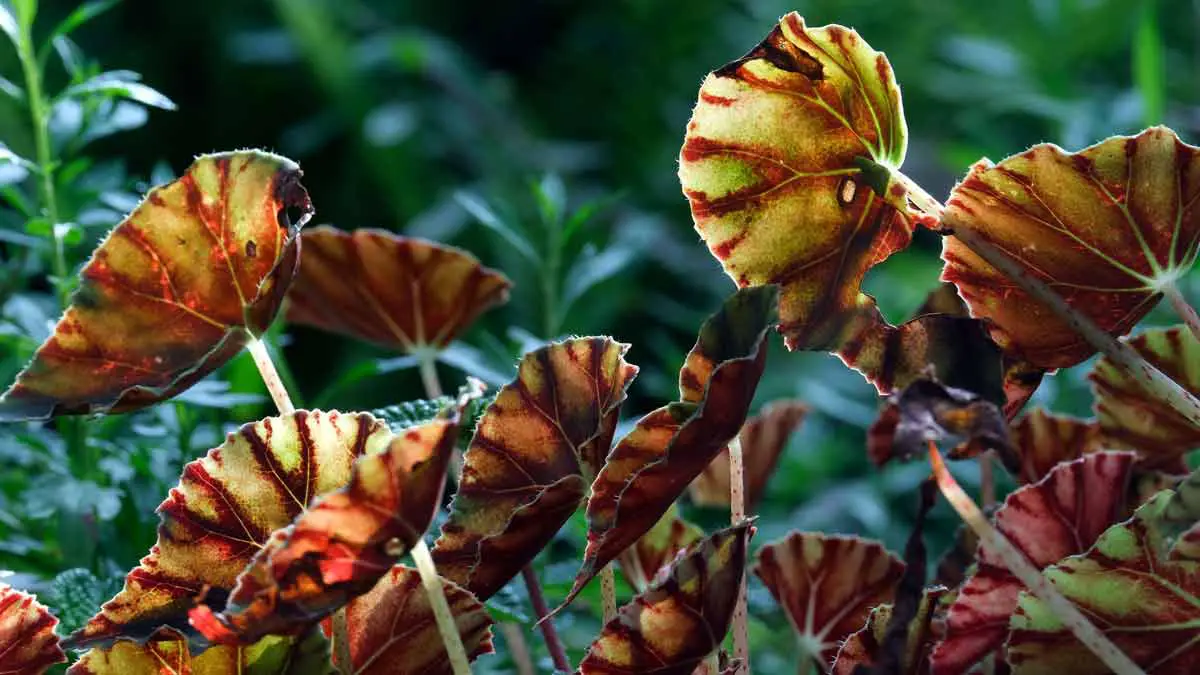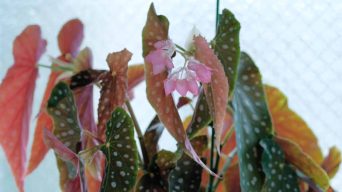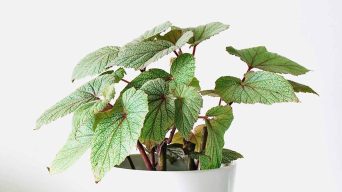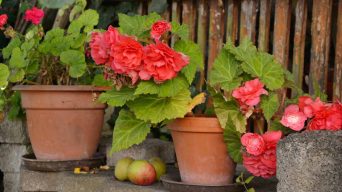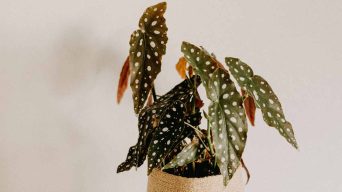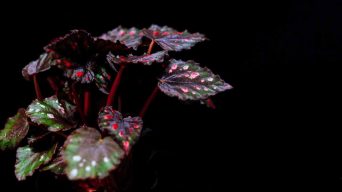Begonia leaves may curl for various reasons, like temperature changes, water issues, and nutrient deficiencies. The optimal temp is above 60°F. Fix it by identifying the cause and taking suitable measures like adjusting watering, temperature, and humidity, providing nutrients, and treating diseases/pests.
Begonias are stunning indoor plants known for their showy flowers and beautiful foliage.
But when begonia leaves start curling, your beautiful plant can quickly become a cause for concern.
This blog post will explore the various causes of curled Begonia leaves and provide practical solutions to ensure your plant remains healthy and vibrant.
Causes Of Begonia Leaves Curling
Begonia plants are prized for their showy flowers and striking foliage.
However, if you notice that the leaves on your Begonia are curling, it could be a sign of several underlying issues.
Some possible culprits are overwatering, underwatering, temperature fluctuations, and pest infestations.
Nutrient deficiencies or inadequate light exposure can cause Begonia leaves to curl.
Understanding the causes of this issue can help you take corrective measures and ensure the healthy growth of your Begonia plant.
Overwatering Or Underwatering
One of the most common culprits behind Begonia leaves curling is improper watering, whether overwatering or underwatering.
Overwatered Begonias are prone to root rot, which hampers their ability to absorb water and nutrients properly.
This results in curled, yellow leaves that may turn brown if left untreated.
To strike the right balance when watering your begonia plant, assess the soil’s moisture before each session.
Ensure the top inch of potting soil feels dry before giving your plant a drink – this can range from once a week in warmer seasons to every two weeks during cooler months.
Be sure not to let your Begonia sit in soggy soil; instead, allow excess water to drain out using pots with drainage holes or lifting saucers after watering.
Temperature And Humidity Fluctuations
Temperature and humidity fluctuations can be a significant factor in Begonia leaves curling.
Begonias, including the popular Polka Dot Begonia (Begonia maculata), prefer stable environments with consistent temperature and humidity levels.
For instance, if your indoor plants experience an abrupt change from comfortable room temperature to scorching heat near a heater or direct sunlight, it could lead to leaf curl as they attempt to conserve water by reducing surface area exposure.
Likewise, low and high humidity can negatively impact begonias – overly dry air may cause crispy brown leaf tips. At the same time, excessive moisture might lead to root rot or powdery mildew infections that trigger curled leaves.
Closely monitoring the temperature and humidity around your Begonia plants and using humidifiers or pebble trays for increasing moisture where needed will help control environmental factors contributing to curling leaves on these beautiful houseplants.
Insufficient Or Excessive Light
Insufficient or excessive light can significantly impact your begonia plant’s health, often resulting in curling leaves.
Begonias thrive in bright indirect sunlight but may suffer if exposed to direct sun for extended periods.
On the other hand, inadequate lighting can lead to weak and spindly growth, making Begonia more susceptible to pests and diseases such as powdery mildew.
To find the ideal spot for your Begonia maculata, observe how sunlight changes throughout your indoor space at different times.
Pests And Diseases
Another common cause of begonia leaf curling is pests and diseases.
Insects like spider mites, mealybugs, and thrips can suck the sap out of leaves, causing them to curl up and turn brown.
Powdery mildew and leaf spot are fungal diseases leading to curling leaves.
To prevent pests and diseases, it’s important to regularly inspect your plant for any signs of infestation or infection.
If you notice any issues, treat them promptly with an appropriate insecticide or fungicide.
Nutrient Deficiency
Nutrient deficiency is one of the common causes of Begonia leaves curling.
This occurs when there’s a lack of specific nutrients the plant needs, such as nitrogen, phosphorus, and potassium.
Insufficient or imbalanced fertilization can often cause this problem.
To prevent these deficiencies from occurring, it’s important to use the right type and amount of fertilizer for Begonias at the right time during their growing seasons.
Additionally, soil testing can identify which nutrients are missing from your soil so you can add them accordingly.
Solutions To Curling Begonia Leaves
If you’re struggling with curled Begonia leaves, don’t worry – several solutions are available.
If you’re struggling with curled Begonia leaves, don’t worry – several solutions can help!
First, ensure you’re watering the plant properly and maintaining appropriate temperature and humidity levels.
Additionally, look for any pest or disease problems and address them promptly.
Applying fertilizer and placing the plant in a location with indirect bright light can also provide the necessary nutrients for healthy growth.
Read on for more tips on treating and preventing curled Begonia leaves.
Adjusting Watering Habits
If your begonia leaves are curling, adjusting your watering habits can be a simple solution to the problem.
Here are some tips for watering your begonias:
- Water your begonias only when the top inch of soil is dry. Overwatering can lead to soggy soil, which can cause root rot and curling leaves.
- When you water your begonias, ensure the soil is moist but not soaking wet.
- Be mindful of how much water you give each plant. Begonias in smaller pots will dry out faster than in larger pots, so adjust your watering schedule accordingly.
- If you have trouble remembering when to water your plants, try setting a reminder on your phone or using a self-watering pot that releases water slowly over time.
Temperature And Humidity Control
Proper temperature and humidity control are crucial in preventing Begonia leaves from curling.
Here are some tips for maintaining the right conditions:
- Begonias prefer temperatures between 60-75°F during the day and 55-65°F at night. Avoid exposing them to extreme temperatures, as hot temperatures can cause leaf curling.
- Maintain a consistent level of humidity around your begonia plant. These tropical plants thrive in a humid environment, usually around 50-60%. You can increase humidity levels by placing a water tray near the plant or using a humidifier.
- Keep your Begonia away from cold drafts or air conditioning vents that could cause sudden temperature changes.
- If your Begonia is not getting enough light, it may start to curl its leaves to conserve moisture. Ensure they’re receiving bright, indirect light for most of the day.
- Regularly fertilize your plant with a balanced fertilizer to provide essential nutrients to keep it healthy and strong.
Addressing Pest And Disease Issues
If you notice curling leaves on your begonia plant, the first thing to check for is pests and diseases.
Here are some solutions to address this issue:
- Use an insecticidal soap or neem oil to eliminate pests like spider mites or mealybugs that might be causing curling leaves.
- If you suspect fungal diseases like powdery mildew or leaf spot, prune off the affected leaves and treat them with a fungicide.
- Ensure good air circulation and avoid overcrowding plants to prevent diseases from spreading.
- Quarantine new plants before adding them to your collection to prevent introducing pests and diseases to your existing plants.
Remember that early detection is key regarding pest and disease issues on your plants.
Regularly inspecting your Begonia for any signs of problems can help prevent a minor issue from becoming a major one.
Applying Fertilizer
Applying fertilizer is an essential step in taking care of your Begonia plant.
A balanced fertilizer with equal parts nitrogen, phosphorus, and potassium is needed to promote healthy growth in your Begonia.
It’s important not to overdo it when applying fertilizer, as this can cause the leaves to curl.
Overfertilizing will inhibit root development and reduce the plant’s ability to absorb nutrients.
To prevent overfertilization, apply a water-soluble or slow-release fertilizer every two weeks during the growing season for the best results.
To ensure that you are using the right kind of fertilizer for your plant’s specific needs, consult with a gardening expert at a local nursery.
They can advise you on which plant food would work best for your particular species of Begonia.
Remember that not all fertilizers are created equal – look out for products explicitly labeled for indoor plants or tropicals like your Begonias.
Choosing A Suitable Location For The Plant
Begonias thrive in bright, indirect light and temperatures between 60-75°F.
Choosing the right location for your Begonia plant is essential to prevent its leaves from curling.
If the plant receives too much direct sunlight, its leaves can burn and curl.
To ensure that your Begonia grows in a suitable location, place it near a window with bright filtered light or under grow lights if natural lighting is insufficient.
If you are growing Begonias indoors and there isn’t enough natural light available in your home or office space, supplement with artificial grow lights installed above them to provide additional brightness required by these plants.
Tips for Preventing Curling Leaves on Begonia Plants
Preventing Begonia leaf curling is critical to keep your plant healthy and beautiful.
Here are some prevention tips you can follow to avoid begonia leaf curl:
- Ensure the plant receives enough bright indirect light, but avoid exposure to direct sunlight, which can cause leaf curl.
- Use a potting soil with good drainage to prevent soggy soil that can lead to root rot and curled leaves.
- Water your Begonia regularly, but do not overwater it, as excessive moisture can cause leaf curl and brown spots.
- Maintain proper humidity levels between 40-60% by placing a humidifier or pebble tray next to the plant, which will prevent low humidity-related issues such as dry leaves and browning of the edges.
By following these prevention tips, you can ensure your Begonia grows healthy and happy!
Final Thoughts
Curling Begonia leaves can be a frustrating problem for plant owners.
Still, it is essential to understand that various causes and solutions are available.
By adjusting watering habits, controlling temperature and humidity levels, applying fertilizer, and addressing pests or diseases when necessary, you can effectively prevent and treat curled leaves on your beautiful Begonias.
With proper care and attention to the needs of your plants, you can enjoy healthy foliage and stunning flowers year-round.

